When it comes to living the van life, there’s thousands of articles on the internet all about tips and hacks to make this dream lifestyle easier.
From what accessories to use to how to find free camps, the amount of resources out there is immense.
One topic that rarely gets brought up though is safety, and how to ensure you can get from one destination to the next with the minimum amount of risk.
There’s lots of elements to vehicle safety, and a lot of it comes down to the model and age of campervan you buy. Unless you have a large budget and can buy a brand new van with the latest bells and whistles, you may end up having little control over a lot of features.
One thing you have complete control over though are the tyres you choose to put on your van.
Yet for some reason, most people will go to a tyre store and simply pick up a set of whatever is cheapest, without doing any research on the products they’re trusting to keep their van on the road.
Even then, when they do buy new tyres, it’s usually after letting their rubber get so worn down that it’s no longer safe (or legal).
For us safety is of the utmost importance. After all, our van is literally our home, transport and office, so we want to make sure everything is running smoothly.
That’s why when it comes to something as essential as tyre safety, we take it pretty seriously.
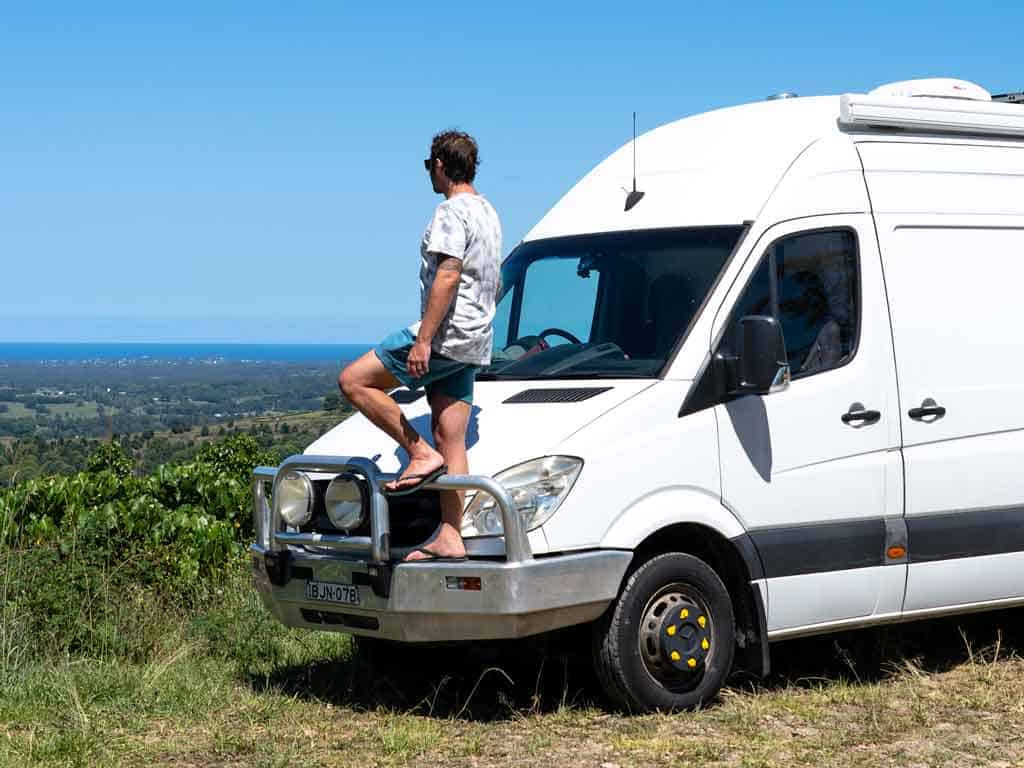
Tyre Safety – Why Continental Tyres are the Best Option for Your Campervan
A few months ago we replaced all 6 wheels (yes 6!) on Marlee with a completely new set of Continental ContiVanContact 100 tyres.
The old tyres were getting worn down, and with the amount of kilometres we put on the clock in all kinds of terrain, it was something we wanted to take care of before we drove much further on our travels around Australia.
When the team at Continental Australia reached out to us with the idea of using their tyres on our road trip, the first thing we did was research whether they were the best option for us.
We’ll be the first to admit that we’re not tyre experts, and definitely not tyre company experts. So we suddenly found ourselves on a deep dive of all kinds of information that was new to us.
What we did find was that Continental Tyres have been around since 1871, and are regularly ranked as the global leaders when it comes to tyre safety, research and development.
They lead the way in technology for a variety of tyre products, especially when it comes to passenger cars, commercial and special vehicles, as well as motorcycles.
They also make a fantastic tyre specifically for van and transport vehicle – the ContiVanContact 100 which we’d eventually end up with.
Having looked into the company, read a bunch of reviews and compared their competitors, we felt comfortable fitting some Conti tyres to Marlee.
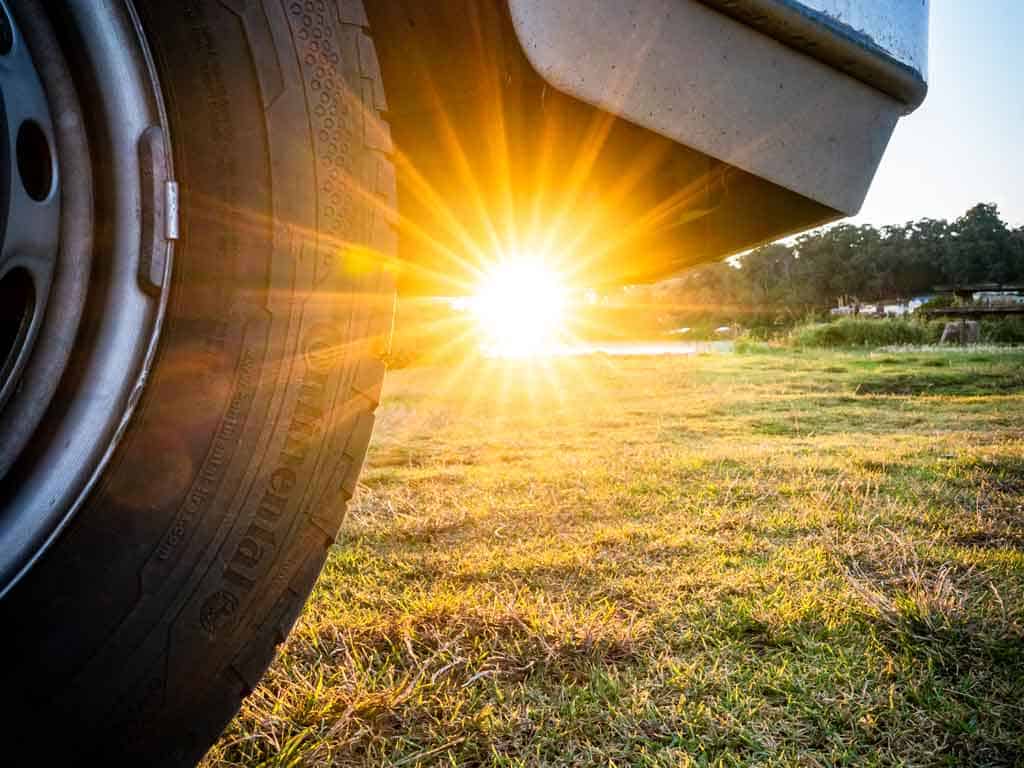
How to Choose Tyres for Your Van
If you don’t have the luxury of time to research every brand and model of tyre for your vehicle like we did, at the very least there are a few things you should consider when choosing campervan tyres.
Make Sure the Tyres Match Your Vehicle
Don’t just wander into a tyre centre and buy whatever is the cheapest in the shop. You need to make sure that whatever model you end up with is the right type for your vehicle!
The first thing you need to do is check the size of them. You can find this information in your vehicle manual (if you are using original wheels), or printed on the side of your existing tyres.
You’ll see a bunch of numbers and letters that look like this: 195/75R16C
- The first number is the width of your tyre.
- The second number is the aspect ratio of the sidewall height of the vehicle.
- The first letter is the radial construction.
- The third number is the rim size.
- The final letter is the speed rating. Essentially what the maximum speed the tyres are designed to handle.
You don’t really need to know what any of that means. But you do need to take note of the exact numbers and letters so you can tell that to the tyre fitters.
Finally you need to make sure that whichever tyres you buy are designed specifically for your vehicle type.
If you’re driving a passenger sedan, you need sedan tyres. Have a motorhome? You need van tyres that are designed for heavier loads. So on and so forth.
Again, you don’t need to dive into the finer details of each one. Just make sure whatever you get is correct for your vehicle.
Get a Reliable and Well-Engineered Brand
We definitely don’t recommend going cheap and buying a no-name brand of tyre that is on sale. Instead stick to a company that is known and trusted around the world.
Yes, it will cost you slightly more than the bargain model. But we’re talking about something that legitimately keeps your vehicle on the road in all conditions. Do you really want to put your life at risk to save a few hundred dollars?
And unless you’re a revhead or don’t do simple tyre maintenance, a new set should last you around 40,000km of regular driving, so it’s not exactly an expense you have to make every month luckily.
Continental Tyres are a brand you can trust, as they invest heavily in research and development to ensure their products are the safest on the road.
Consider Your Driving Style and Weather Conditions
Do you primarily stick to highways and paved roads? Like to spend a bit of time navigating gravel and dirt roads? Have a 4×4 vehicle and plan on heading off on difficult and rough tracks? Or maybe you have a sports car and will be hitting race tracks on your weekends.
All these things are something to consider when looking at which particular model of tyre you’d like to go for. The more technical, fast or dangerous your driving style, the better (and more expensive) your tyres need to be.
Finally think about the weather you’ll be experiencing. If you are likely to drive a lot in the snow, you’ll need winter-specific tyres. Same if you live in extremely wet areas.
For our Mercedes Sprinter campervan, the Continental ContiVanContact 100 tyres are the perfect blend of reliability and safety for a mix of mostly paved with some unsealed roads on our travels around Australia.
No Matter What, Get a Wheel Alignment
Whichever tyres you end up choosing, make sure you get a full wheel alignment once you have them fitted.
This ensures that your wheels are perfectly balanced to provide even wear across the entire tyre, while providing safe handling on the roads.
Keep in mind that a full wheel alignment actually include three parts – Camber, Caster and Toe.
- Camber is the inward and outward tilt of the tyres when viewed from the front
- Caster is the forward or backward slope of the steering axis
- Toe is the difference from both sides between the front and rear of the front tyres.
Not all tyre fitters can adjust all three aspects of wheel alignments, so make sure you ask before paying them.
Because our campervan is so heavy, we ended up going to a truck wheel alignment specialist to have ours done.
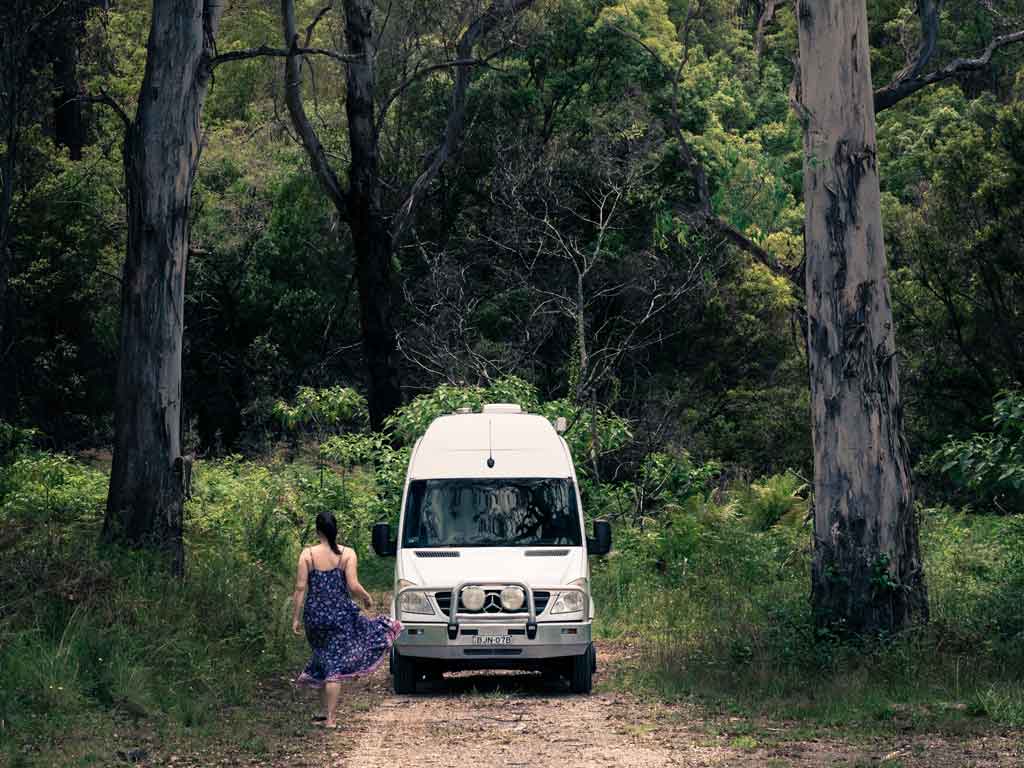
Tyre Maintenance – How to Look After Your Tyres
There a few basic things you can do to keep your new tyres safe and prolong their life.
Check Tyre Pressures Regularly
Ensure that your tyres are always inflated to the correct recommended tyre pressure.
You can find the exact number required on the vehicle placard (usually installed on the inside of the driver’s side door jamb), or check with your local tyre fitter.
If you don’t want to manually be checking this all the time, look at installing an RV TPMS, which automatically monitors your pressure and lets you know via display or audible warning sounds if it drops.
Marlee runs 70psi on the front, and 65psi on the rear wheels.
Bonus tip – Always check the tyre pressure when the tyres are cold and haven’t been driven long distances for accurate measurements.
Rotate Tyres Every Service
Even with a a proper wheel alignment done, tyres do occasionally get worn out unevenly, especially on the front axle. When you have your standard vehicle service, ask the mechanics if they can do a tyre rotation.
You can also do this yourself, if you have the right equipment. Make sure it’s done every 10,000km.
Inspect Tyres Every Day
This literally takes 30 seconds, but could save your life.
Every morning when you go to start your next drive day, do a quick walk around of your car to look at the tyres.
You’re checking to make sure they aren’t flat, don’t have any unusual wear marks, obvious damage, etc.
Balance and Alignments
These are usually done during tyre fittings or services, but they may need to be done again if you have any large impacts such as hitting a pothole very hard, mounting a kerb at speed, etc.
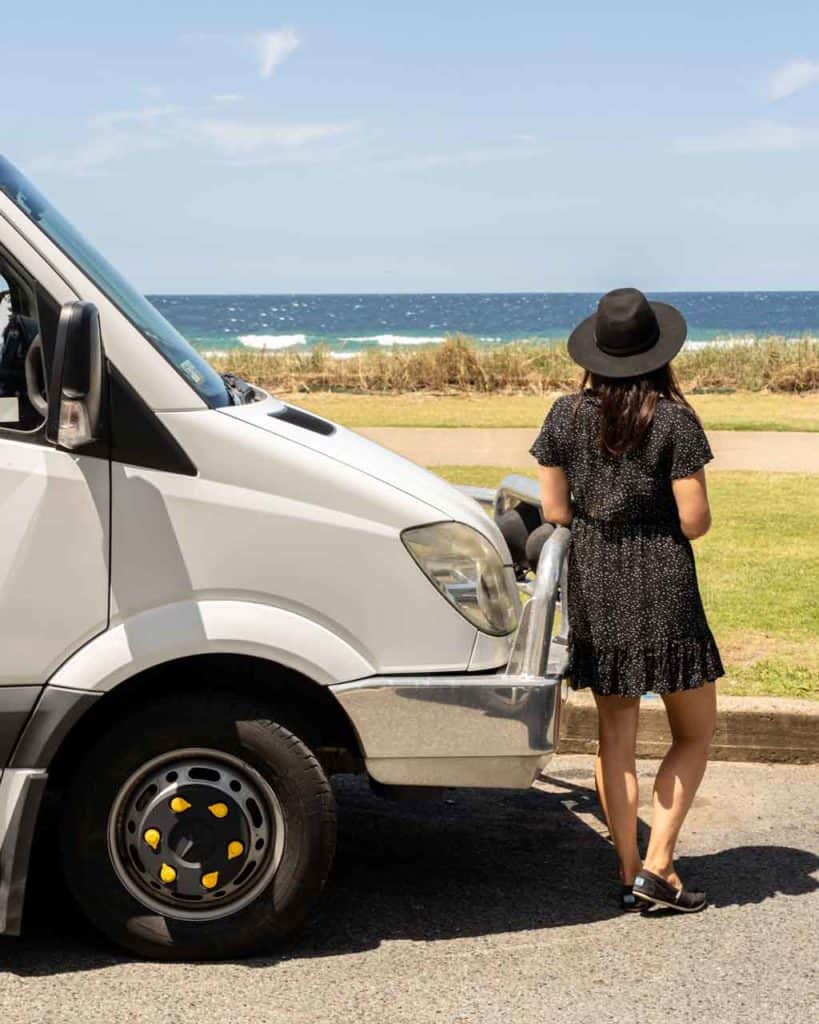
Crazy Statistics – The Tyre Report by Continental
In case you needed more of a reason why you need to take tyre safety seriously, check out these statistics discovered by Continental Tyres when they conducted their groundbreaking Tyre Report in Australia last year.
29% of Australians don’t know how to change a flat tyre on their car
That’s right – almost 1/3 of Aussies would be completely stuck if they got a flat tyre out in the middle of nowhere.
That number gets worse the younger the demographic. For Australians under the age of 30, it’s 50% that couldn’t change a tyre!
If we break it down by state, Tasmanians are the most tyre savvy, with 87% able to change a flat. Victorians are at the bottom of the list with only 67% knowing what to do if they end up with a puncture on the side of the road.
Legal FACT
The lowest legal level of tread on a tyre in Australia is 1.66mm. 53% of Australians don’t know this.
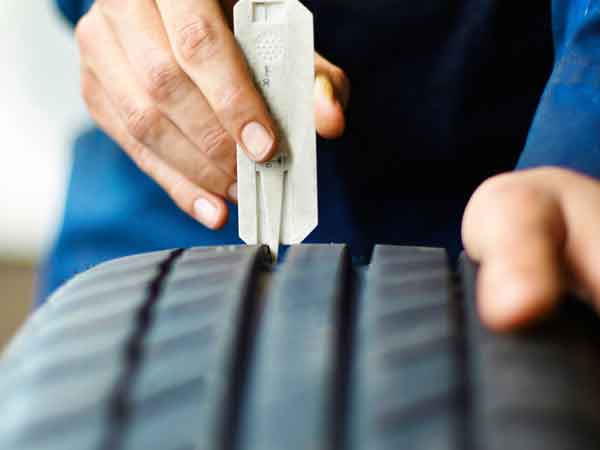
51% of Millennials are Unable to Conduct Basic Tyre Safety Tests
A basic tyre safety test is very simple, and as long as you’re checking tyre pressure, tread and quality, you should be be able to get a lot more life out of your tyres.
Surprisingly the majority of millennials don’t know how to check this.
Male vs Female
At the risk of starting a gender war, some stats came out specifically about how men and women handle their tyre knowledge.
In the event of a flat tyre:
90% of men know how to change a flat tyre, while 53% of women know how to change a flat tyre.
60% of men fix the issue themselves, while 20% of women fix the issue themselves.
33% of men will call roadside assistance, while 51% of women will call roadside assistance.
Although there’s always a chance that a higher percentage of men just won’t admit they don’t have the knowledge to fix a flat. Just saying…
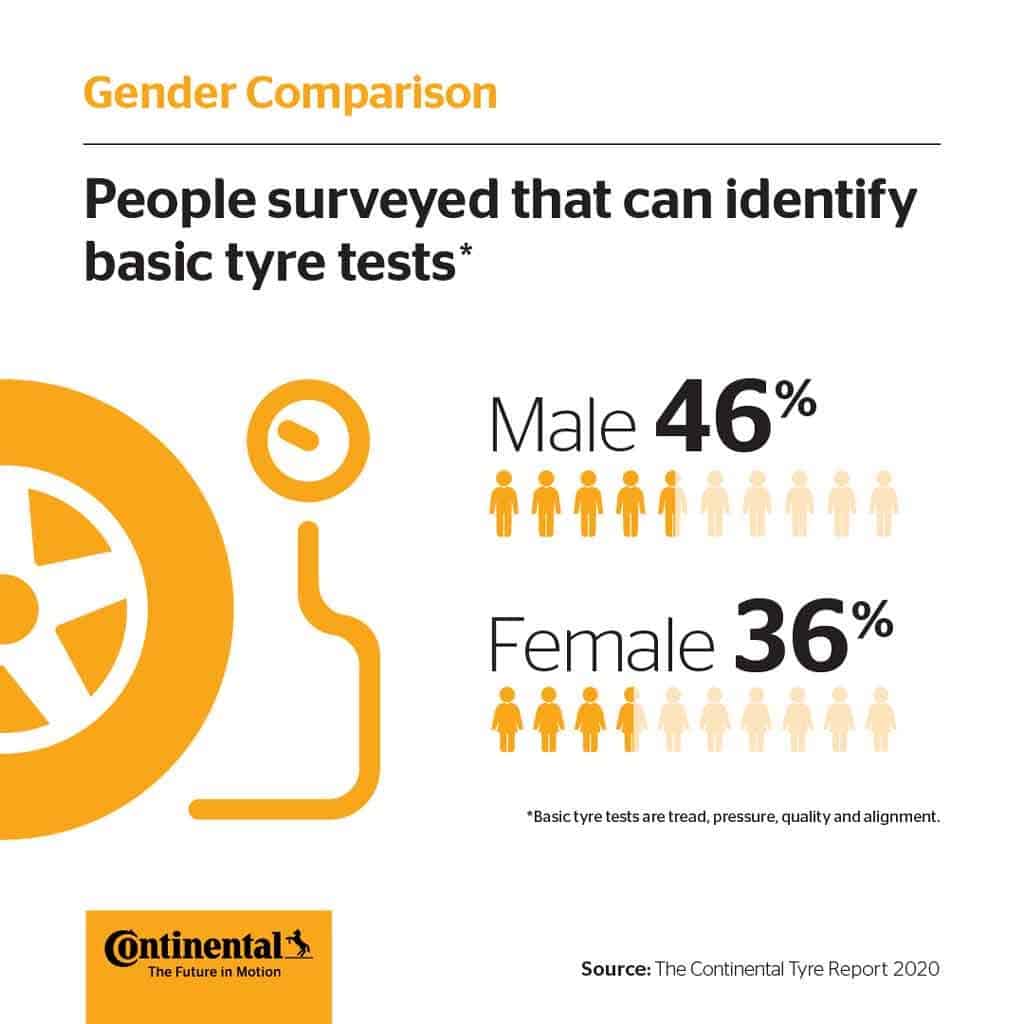
That’s it for our round-up on tyre safety, tips for how to look after your tyres, and why we ended up putting Continental tyres on our van.
It might not be the sexiest topic, but it is something that’s very important, and is often overlooked when it comes to #vanlife.
If you have any questions please don’t hesitate to reach out. Drive safe!
Disclaimer: We worked with Continental Tyres as their brand ambassadors in 2020/21, and were gifted the tyres as part of our partnership. That being said, we only work with brands that we know and trust, especially when it comes to our safety and the safety of others on the road. We were not asked to write this article, and Continental have had no editorial input on its publication.



Thanks for the article. I don’t think there’s a more important piece of safety equipment on you van than the tyres. Another factor ignored by most vanlifers and other motorists is to make sure the tyres they purchase have the correct load and speed rating as specified by the van manufacturer. So as well as buying the correct size, for example 215/65R16 for my Kombi, the tyres also have to be rated at 106/104 relating to the load-bearing capacity and ‘T’ for the speed rating. Ignoring this could have safety implications and miget affect insurance cover.
Enjoy your travels!